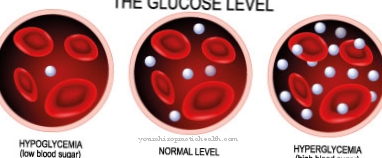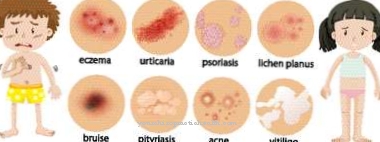The Amyloidosis refers to a pathological accumulation of proteins in the intercellular spaces. Amyloidosis itself is not a disease; rather, it causes various diseases. The amyloidosis can only be detected by means of a cytological examination of a tissue sample. It almost exclusively affects older patients around the age of 65. Amyloidosis can only be treated to a limited extent and is fatal about 24 months after it occurs.
What is amyloidosis?

Amyloidosis is a disorder of protein metabolism. A certain protein (e.g. immunoglobulin, cystatin or lysozyme) cannot or only insufficiently be broken down in a patient suffering from amyloidosis.
As a result, the protein accumulates in the spaces between the cells of various organs - such as the liver, kidneys or heart - and impairs organ activity. The amyloidosis becomes visible through various diseases that the patient develops. These include, for example, an abnormally enlarged liver, an inflamed heart muscle, unspecific kidney failure or cancer of the bone marrow (multiple myeloma).
Occasionally there is an accumulation of proteins in several organs at the same time, so that several organs become ill or fail (multiple organ failure).
causes
The causes of amyloidosis lie in a disorder of the protein metabolism. Proteins are usually found in dissolved form in blood serum.
If the protein is not dissolved or broken down, the concentration is too high. If it cannot be excreted, the protein accumulates in the spaces between the cells. There it is attacked by enzymes; as a result, long chains of amino acids are created, which become visible as small fibers under the microscope.
The fibers cannot be dissolved and broken down. As a result, the organ is destroyed until it is completely inoperable. So far it has not been possible to determine which patients tend to develop amyloidosis; According to the current state of research, a genetic predisposition is assumed.
You can find your medication here
➔ Medicines for cardiac arrhythmiasSymptoms, ailments & signs
In the worst case, amyloidosis can lead to death. The complaints are also relatively serious and should therefore be treated at an early stage. As a rule, the patients suffer from severe cardiac insufficiency. This leads to permanent tiredness and fatigue.
The patient's resilience also decreases significantly due to the amyloidosis. In the further course of the disease leads to disturbances of the heart rhythm, whereby the heartbeat itself can change. Even light activities can appear very strenuous for the patient, so that there can be restrictions in everyday life. As a result of these restrictions, many sufferers also suffer from depression or other psychological disorders.
Amyloidosis can also lead to dementia. In this case, those affected are often dependent on the help of other people in their everyday life and the quality of life decreases significantly. The stiffening of the heart muscles also reduces the life expectancy of the person affected. Amyloidosis also significantly increases the risk of a heart attack or stroke. Pain in the heart can also lead to a panic attack or fear of death.
Diagnosis & course
A diagnosis can only be made by means of a cytological examination. If typical secondary diseases - such as an enlarged liver, cardiac arrhythmia or kidney failure - have occurred, the doctor should consider amyloidosis and carry out an appropriate laboratory examination.
For this purpose, a tissue sample (biopsy) is taken from the affected organ and then examined under the microscope. Amyloidosis is visible through the microscopically visible thread-like structures between the cells. The tissue sample is stained with the dye Congo red. A greenish discoloration of the intercellular spaces is visible under polarized light. A scintigraphy can provide information about the spread of amyloidosis. During a scintigraphy, a radioactive substance is given that is able to bind the amyloidosis and make it visible.
The amyloidosis itself goes unnoticed by the patient. With the progression of amyloidosis - the deposits spread relatively quickly - there are clearly visible secondary diseases that severely impair the quality of life. Depending on the course, there is an organ insufficiency or an organ failure. Amyloidosis is fatal - around 24 months after it first occurs, one or more organs are no longer functional.
Complications
Amyloidosis, which occurs rarely, has a massive impact on the body's protein balance and changes it. As a result of the insoluble deposit, the vessels, nerves and bones are attacked.The antibodies can no longer disintegrate. If the symptom occurs, a systemic variant can lead to chronic flare-ups and can assume life-threatening proportions.
Amyloidosis cannot be cured, but it can be treated in a targeted manner. Early diagnosis helps to keep the risk of complications low. This largely spares the patient a possible deterioration in the function of organs and nerves. Amyloidosis occurs gradually. If it shows organ-related symptoms, the organ function can already be impaired to such an extent that it has to be transplanted.
Either the screening method or a tissue sample is considered to make the diagnosis effective. Then the symptom is typed. Due to the variety of the disease, this process must be carried out very carefully. Only when the faulty protein has been identified is a comprehensive therapy plan drawn up.
Chemotherapy as part of medication has proven to be a successful treatment method. Under certain circumstances, the patient may experience tiredness, exhaustion and gastric disagreements as a result of drug administration. Therefore, this form of therapy is strictly recorded under medical supervision. It is important as a patient to adhere to a diet that is as low in salt as possible in order to limit further complications.
When should you go to the doctor?
Amyloidosis always requires medical treatment. If there are obvious signs of the disease, a doctor must be consulted quickly. The doctor can then determine whether it is amyloidosis and initiate appropriate treatment.
Patients with chronic infections and inflammations such as arthritis or tuberculosis as well as patients on long-term dialysis and certain forms of bone marrow cancer (e.g. multiple myeloma) are particularly at risk and should speak to the responsible doctor immediately if amyloidosis is suspected.
This is especially true for older patients from the age of 40. If they notice increasing weakness and weight loss, a doctor's visit is necessary. Since the organism is already weakened by the underlying disease, the amyloidosis must be treated immediately.
If any family history of inherited amyloidosis is known, medical advice is recommended at the first signs of illness. At the latest when skin changes such as bruises and swellings, cardiac arrhythmias and difficulty swallowing occur, a doctor must be consulted with amyloidosis.
Doctors & therapists in your area
Treatment & Therapy
Amyloidosis can only be treated to a limited extent. For the treatment of secondary diseases, however, there are some therapies available that can slow down the course.
If the heart is involved, a low-salt diet is recommended, as is the case if the kidneys are involved. Diuretics can also be given. Diuretics help the body flush out water and thus proteins.
The use of a pacemaker can be useful to counteract any cardiac arrhythmia; dialysis is indicated if the kidney function is severely impaired to less than 15%.
Outlook & forecast
The further course of amyloidosis usually depends on the underlying disease and its treatment, so that a general course of the disease cannot be predicted in most cases.
As a rule, however, amyloidosis leads to severe discomfort in the heart, leading to cardiac insufficiency and disorders of the heart rhythm. This also significantly reduces the patient's resilience and normal activities in everyday life or doing sports are no longer possible due to this disease. The quality of life is significantly reduced by this disease.
Dementia can also develop, which significantly limits the patient's everyday life. The patient may also need the help of other people in order to be able to cope with everyday life. Renal insufficiency can also occur, making the patient dependent on a transplant or dialysis.
Direct treatment of amyloidosis is usually not possible. Most complaints can be restricted and reduced through a special diet. However, the patient's life expectancy may be reduced. In some cases a pacemaker can also be installed.
You can find your medication here
➔ Medicines for cardiac arrhythmiasprevention
According to current research, amyloidosis cannot be prevented. In familial amyloidosis, lifelong use of colchicine may delay an onset of amyloidosis. Sometimes chemotherapy with melphalan followed by blood stem cell therapy can delay amyloidosis.
If amyloidosis is suspected, if it can be assumed that the heart and kidneys will be affected, preventive care can be taken to stick to a low-salt diet.
Aftercare
In the case of amyloidoses, follow-up care depends on the type and severity of the disease and the patient's individual symptoms. As a rule, long-term follow-up care with regular follow-up checks is necessary for amyloidoses. Usually various organs as well as the endocrine system and soft tissue are affected.
A doctor must examine all of these areas and, if necessary, consult other specialists, as new symptoms can occasionally appear that require further diagnosis. Aftercare always includes regular adjustment of the medication. The patient usually has to take pain relievers, anti-inflammatory drugs and other preparations that have to be adjusted to the current course of the disease at intervals of a few weeks to months.
If the outcome is positive, general measures such as the use of ACE inhibitors and diuretics can be gradually reduced. If the course is severe and involves the kidneys, dialysis treatment must be continued permanently. Regular follow-ups are particularly necessary after chemotherapy, as is done in AL amyloidosis.
Due to the many manifestations of the disease, individual follow-up care can only be determined by a doctor. Those affected should consult the responsible doctor at an early stage so that the therapy concept can be effectively implemented.
You can do that yourself
Amyloidosis cannot yet be treated causally. The self-help measures focus on lifestyle changes and the use of alternative remedies. Basically, the medication must be optimally adjusted. The patient should note any side effects and interactions and inform the doctor about them. Unusual symptoms also need to be clarified before serious complications become noticeable.
If cardiac arrhythmias develop, the use of a pacemaker is indicated. Patients who experience noticeable symptoms are best to speak to the doctor responsible and have a comprehensive cardiological examination carried out. A proven natural remedy is green tea. The remedy prevents heart problems and also supports kidney function. In addition, the patient must regularly take diuretics to help the body flush out fluids and thus proteins.
Alternatively, there is a homeopathic treatment. As part of the therapy, the homeopath works out the individually suitable remedies and prescribes them with regard to the current state of health of the person concerned. This allows the disease to be treated retrospectively by slowing down the disease process. A complete cure is unlikely with homeopathic treatment, but alternative therapy can have a positive effect on the course of the disease and ease the symptoms.

.jpg)






.jpg)



















